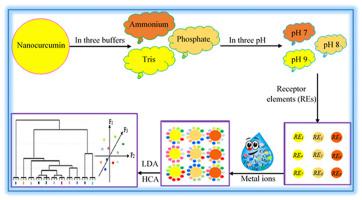Talanta ( IF 6.1 ) Pub Date : 2021-01-23 , DOI: 10.1016/j.talanta.2021.122131 Zolaikha Rasouli , Raouf Ghavami

|
Here, a facilely constructed 3 × 3 visible-light cross reactive sensor array based on nanoaggregation of curcumin (Cur) is proposed for the identification and quantification of metal ions (MIs). Synthesis of nanocurcumin (NCur) was characterized by UV–Vis spectrophotometry, transmission electron microscopy (TEM) and Fourier transform infrared (FT-IR). The average particle size was estimated about 5.21 ± 1.13 nm) n = 50 (. Our sensor array consists of nine receptors with distinct but overlapping specificities for 11 MIs: Al3+, Cd2+, Co2+, Cu2+, Hg2+, Fe2+, Fe3+, Mn2+, Ni2+, Pb2+, and Zn2+. The receptors include the nine solutions of NCur at three buffers of phosphate, ammonium, and tris each at three pH of 7, 8, and 9 (in total 9 receptors). On account of different pH and buffers, NCur-MI binding affinities can be distinguished by monitoring the UV–Vis absorbance changes. These changes are optical fingerprints that can be used to identify each MI. The absorption values in sixteen wavelengths (i.e. 332, 352, 372, 392, 412, 432, 452, 472, 492, 512, 532, 552, 572, 592, 612, and 632 nm) are considered as analytical signals to quantitatively evaluate of the absorbance responses of the sensor array. A color difference map is provided to qualitatively visualize of the colorimetric sensor array responses. Under optimal conditions, the MIs are successfully discriminated in the range of 4–48 μmol L−1. The limit of detections (LODs) values ranged from 0.47 (for Fe3+) to 1.40 μmol L−1 (for Pb2+). Furthermore, two different mixing sets of the MIs are prepared for multivariate multicomponent analysis. Finally, the suggested sensor array is employed to evaluate its practicability in the discrimination of MIs in samples of river water and serum. Moreover, it can identify the MIs in these samples. The sensor array presents a simple, save time, cost-effective, and environmentally friendly method for the identification and quantification of MIs.
中文翻译:

基于姜黄素在不同pH下的纳米聚集和缓冲液的3×3可见光交叉反应传感器阵列,用于金属离子的多变量识别和定量
在此,提出了一种基于姜黄素(Cur)纳米聚集的结构简单的3×3可见光交叉反应传感器阵列,用于金属离子(MI)的鉴定和定量。紫外-可见分光光度法,透射电子显微镜(TEM)和傅立叶变换红外(FT-IR)表征了纳米姜黄素(NCur)的合成。估计平均粒径约为5.21±1.13 nm)n = 50(。我们的传感器阵列由9种受体组成,这些受体对11种MI具有不同但重叠的特异性:Al 3+,Cd 2 +,Co 2 +,Cu 2 +,Hg 2+,Fe 2 +,Fe 3+,Mn 2 +,Ni 2 +,Pb 2+和Zn 2+。受体包括在三种磷酸盐,铵和tris缓冲液中的NCur的九种溶液,每种缓冲液的pH分别为7、8和9(总共9种受体)。由于pH和缓冲液的不同,可以通过监测UV-Vis吸光度变化来区分NCur-MI结合亲和力。这些变化是可以用来识别每个MI的光学指纹。十六个波长(即332、352、372、392、412、432、452、472、492、512、532、552、572、592、612和632 nm)的吸收值被视为定量分析的分析信号传感器阵列的吸光度响应。提供色差图以定性地可视化比色传感器阵列响应。在最佳条件下,成功识别出MI的范围为4–48μmolL -1。检出限(LODs)的范围为0.47(对于Fe 3+)至1.40μmolL -1(对于Pb 2+)。此外,准备了两个不同的MI混合组用于多元多组分分析。最后,使用建议的传感器阵列来评估其在区分河水和血清样本中的MI方面的实用性。此外,它可以识别这些样本中的MI。传感器阵列为MI的鉴定和定量提供了一种简单,节省时间,具有成本效益和环境友好的方法。



























 京公网安备 11010802027423号
京公网安备 11010802027423号